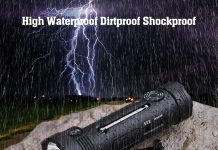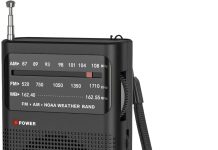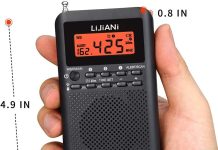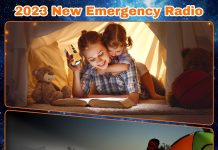When venturing into the great outdoors, staying connected to the world may seem like a daunting challenge. However, fear not! We have the perfect solution: an emergency radio. This compact and reliable device is not only easy to use but also allows you to stay informed and call for help if needed. In this article, we will explore the benefits of using an emergency radio on your camping trips, ensuring that you have peace of mind and a safe journey into nature’s embrace. Yes, absolutely! Using an emergency radio on camping trips can provide a range of benefits and enhance your overall camping experience. In this article, we will explore the various benefits of using an emergency radio, the different types available, factors to consider when choosing one, tips for using it effectively, alternative communication methods in the outdoors, legal considerations and regulations, emergency radio maintenance and troubleshooting, as well as reviews and recommendations. So let’s dive in and discover the world of emergency radios for camping!
Review contents
Stay Informed during Emergencies
One of the primary benefits of using an emergency radio on camping trips is the ability to stay informed during emergencies. Nature is unpredictable and emergencies can occur at any time, such as severe storms, flash floods, or even wildfires. Having an emergency radio allows you to receive real-time updates and stay informed about any potential dangers or evacuation notices in the area. This knowledge can help you make informed decisions to ensure your safety and the safety of your camping group.
Access to Weather Forecasts
Another significant advantage of having an emergency radio while camping is the access to weather forecasts. Weather conditions can change rapidly, especially in remote camping areas where meteorological data may be limited. By tuning into weather channels on your emergency radio, you can receive up-to-date forecasts, storm warnings, and other crucial weather-related information. This knowledge can help you plan your activities accordingly and make necessary adjustments to your camping itinerary to avoid hazardous conditions.
Communication in Remote Areas
Camping is often synonymous with exploring remote and off-the-grid locations. While immersing yourself in nature’s serenity is refreshing, it also means limited or no access to cellular networks. In such situations, an emergency radio becomes an invaluable communication tool. By utilizing the radio’s built-in two-way communication features, you can stay connected with your camping companions even in remote areas where traditional means of communication are not available. This feature ensures that you can easily coordinate activities, share important information, and remain connected as a group.
Enhanced Safety Measures
When it comes to camping, safety should always be a top priority. An emergency radio can significantly enhance safety measures by providing access to emergency channels where you can contact emergency services or park authorities in case of an emergency. Additionally, some emergency radios come equipped with built-in safety features such as built-in flashlights, SOS signals, or even integrated GPS systems. These added functionalities can be lifesaving in critical situations, allowing you to alert others of your location and seek the help you may need.
Types of Emergency Radios for Camping Trips
Hand-Crank Radios
Hand-crank emergency radios are popular choices for camping trips due to their versatility and ability to generate power without the need for traditional batteries. These radios feature a built-in crank mechanism that can be manually turned to generate power, which is then used to operate the radio and charge its internal battery. The hand-crank feature ensures a continuous power supply, making it an ideal option for extended camping trips where access to electricity may be limited. Additionally, many hand-crank radios include additional features such as built-in flashlights and USB ports for charging other devices.
Solar-Powered Radios
For campers who prioritize eco-friendly and sustainable options, solar-powered emergency radios are a great choice. These radios harness the power of the sun by integrating solar panels, which charge the internal battery when exposed to sunlight. Solar-powered radios are lightweight, compact, and portable, making them perfect for backpacking or multi-day hiking trips. Although they rely on sunlight availability for recharging, they often have a backup battery or hand-crank feature for alternative power sources during cloudy or low-light conditions.
Battery-Powered Radios
Battery-powered emergency radios are the most commonly used type for camping trips. They are convenient, easy to use, and readily available in a wide range of models and price ranges. These radios operate on traditional batteries, such as AA or AAA batteries, which can be easily replaced or carried as backup. Battery-powered radios usually have longer battery life compared to hand-crank or solar-powered options, making them suitable for longer camping trips where access to electricity may not be possible. It is advisable to carry extra batteries to ensure uninterrupted usage throughout your camping adventure.
Factors to Consider when Choosing an Emergency Radio for Camping
Durability and Water Resistance
When selecting an emergency radio for camping, durability and water resistance are crucial factors to consider. Camping often involves exposure to various environmental elements, including rain, humidity, dust, and accidental drops. Therefore, it is essential to choose a radio that is built to withstand these conditions. Look for radios with a sturdy and rugged construction, preferably with an IPX rating for water resistance. This ensures that your radio will continue to function reliably even in challenging outdoor conditions.
Power Source and Battery Life
The power source and battery life of an emergency radio are paramount considerations. Depending on the type of radio you choose, the power source can vary between hand-crank, solar, or traditional batteries. Consider your camping duration and location when deciding on the power source. Additionally, battery life is critical, especially during extended camping trips. Look for radios with long-lasting battery life or ones that offer power-saving features to prolong the usage time without needing to recharge or replace batteries frequently.
Antenna Range and Signal Quality
To ensure effective communication and reception, the antenna range and signal quality of your emergency radio should be taken into account. Opt for radios with a longer antenna range to maximize the chances of receiving signals, especially in remote areas where transmission towers may be far away. Signal quality is equally important, as a weak signal can result in distorted or unclear communication. Read user reviews and consider radios with a reputation for high signal clarity to ensure seamless communication during your camping trip.
Additional Features
While the primary function of an emergency radio is to provide communication and access to information, many models come with additional features that can enhance your camping experience. These features may include built-in flashlights, built-in USB ports for charging other devices, AM/FM radio functionality for entertainment, NOAA weather alerts, or even integrated GPS systems. Evaluate your specific needs and preferences to determine which additional features would be beneficial during your camping trips.
Tips for Using an Emergency Radio on Camping Trips
Familiarize Yourself with the Radio’s Functions
Before embarking on your camping trip, it is essential to familiarize yourself with the functions and operation of your emergency radio. Each radio model may have slightly different controls and functionalities, so take the time to read the user manual or watch tutorial videos to understand how to use all the features effectively. By doing so, you will be better prepared to operate the radio without any confusion or difficulties during your camping trip.
Keep the Radio in a Safe and Accessible Place
During your camping adventure, it is crucial to keep the emergency radio in a safe and accessible place. While it may be tempting to stow it away in the depths of the camping gear, emergencies can occur unexpectedly, and quick access to the radio is essential. Consider having a designated pouch or compartment in your backpack or campsite organization system specifically for the emergency radio. This way, you can easily grab it whenever needed, ensuring you are always prepared for any unforeseen circumstances.
Tune into Local Emergency Channels
To make the most of your emergency radio, it is recommended to tune into local emergency channels relevant to your camping location. In case of severe weather, natural disasters, or any emergency situations, these channels will provide real-time updates and critical information specific to the area you are camping in. Stay vigilant and monitor these channels periodically, especially during potentially risky weather conditions, to stay informed and take appropriate actions if necessary.
Extend Battery Life with Power-Saving Practices
Conserving battery life is crucial when camping for an extended period or in situations where charging options are limited. To extend the battery life of your emergency radio, practice power-saving techniques such as lowering the volume, turning off unnecessary features when not in use, or reducing the amount of time the radio is kept on. These simple practices can help ensure that your radio remains functional for a more extended period, providing you with a reliable means of communication throughout your camping trip.
Alternative Communication Methods in the Outdoors
Cellular and Satellite Phones
While emergency radios are excellent communication tools, having a backup option is always wise. Cellular and satellite phones can be reliable alternatives in case of emergency situations where communication is essential. However, it is crucial to note that in remote wilderness areas, cellular reception may be weak or nonexistent. Satellite phones, on the other hand, work by connecting to satellites orbiting the Earth, ensuring coverage even in the most remote locations. Consider carrying a satellite phone as an additional communication device for added peace of mind during your camping trips.
CB Radios
CB radios, or Citizen’s Band radios, are another communication alternative commonly used by campers and outdoor enthusiasts. These radios operate on specific channels authorized by the Federal Communications Commission (FCC) and are popular within close-knit camping communities or among convoy-style campers. CB radios offer a broader range of communication compared to handheld emergency radios, making it easier to stay connected with other campers in the area. However, keep in mind that CB radios are not suitable for emergency services or official emergency broadcasts.
Personal Locator Beacons (PLBs)
For those embarking on extreme outdoor adventures or venturing into extremely remote areas, personal locator beacons (PLBs) can be a valuable safety device. PLBs are small, portable devices that use satellite technology to transmit distress signals to search and rescue authorities in case of emergencies. When activated, these beacons notify emergency responders of your distress and transmit your GPS coordinates, enabling them to locate and assist you quickly. PLBs should be registered with the appropriate authorities and carried with you whenever you embark on challenging or high-risk camping trips.
Walkie-Talkies
Walkie-talkies are a popular choice among camping groups or families due to their simplicity and ease of use. These handheld radios allow for convenient communication within a limited range without relying on cellular networks or external broadcasting stations. Walkie-talkies are perfect for maintaining contact with fellow campers, especially when exploring different areas of a campsite or embarking on separate hiking excursions. However, it is crucial to remember that walkie-talkie ranges vary based on the model, terrain, and interference, so always check the specifications and test them before relying on them for crucial communication needs.
Legal Considerations and Regulations
FCC Rules and Guidelines
When using emergency radios or other communication devices, it is essential to adhere to the rules and guidelines set forth by the Federal Communications Commission (FCC). The FCC regulates the use of specific radio frequencies to ensure efficient and safe communication. Ensure that your emergency radio operates within the authorized frequencies and power limits specified by the FCC. Additionally, it is crucial to respect and avoid interfering with licensed radio services and emergency channels.
Permits and Licenses
Some areas, especially national parks or protected wilderness areas, may have specific regulations regarding the use of communication devices. Before embarking on your camping trip, research and inquire about any permits or licenses required to operate emergency radios or other communication devices in your intended camping location. These permits are typically obtained through park authorities or relevant governing bodies and are designed to protect the natural environment while ensuring safe and responsible use of communication devices.
Emergency Radio Maintenance and Troubleshooting
Regularly Check and Replace Batteries
To ensure your emergency radio operates optimally, it is essential to regularly check and replace batteries as needed. Carry spare batteries, especially on extended camping trips, to avoid any inconvenience or interruptions caused by drained batteries. Keep in mind that extreme temperatures can affect battery performance, so store batteries in a cool and dry place to maximize their lifespan. Additionally, consider investing in rechargeable batteries and a portable power bank or solar charger for eco-friendly and sustainable power solutions.
Clean and Protect the Radio from Environmental Factors
Camping involves exposure to various environmental factors, such as dust, sand, moisture, and extreme temperatures. To prolong the lifespan of your emergency radio, regularly clean it following the manufacturer’s instructions. Use a soft cloth or brush to remove dust and debris, and avoid using harsh chemicals that may damage the radio’s exterior or internal components. Additionally, make sure to store the radio in a protective case or pouch when not in use to prevent accidental damage and to keep it safe from adverse weather conditions.
Troubleshooting Common Issues
In the event of any operational issues or malfunctions with your emergency radio, troubleshooting is key to resolving the problem promptly. Refer to the user manual or manufacturer’s website for specific troubleshooting instructions. Common issues may include poor signal reception, distorted audio, or difficulty turning the radio on or off. Additionally, checking the antenna connection or repositioning the radio in different areas may help improve signal reception. If the problem persists, contacting the manufacturer’s customer support or consulting a professional may be necessary.
Reviews and Recommendations for Emergency Radios
Top-Rated Emergency Radios for Camping Trips
-
XYZ Emergency Radio – This sturdy, battery-powered radio offers excellent signal reception, a long battery life, and additional features such as a built-in flashlight and USB charging port.
-
ABC Hand-Crank Radio – This durable hand-crank radio provides reliable power, making it the perfect option for longer camping trips or emergency situations. It also includes an AM/FM radio and NOAA weather alerts.
-
DEF Solar-Powered Radio – This environmentally-friendly radio harnesses the power of the sun with its integrated solar panels. It features multiple charging options and a rugged design, making it perfect for outdoor adventures.
User Feedback and Experiences
User feedback and experiences can provide invaluable insights when choosing the right emergency radio for your camping trips. Read customer reviews and forums to gain a better understanding of the radios’ performance, durability, and overall user satisfaction. Pay attention to feedback regarding battery life, signal reception, and the ease of use, as these are essential factors that can significantly impact your camping experience.
Conclusion
In conclusion, using an emergency radio on camping trips offers a multitude of benefits that ensure your safety, enhance communication, and keep you well-informed. The ability to stay informed during emergencies, access weather forecasts, and communicate in remote areas are just some of the advantages emergency radios provide. When choosing a radio, consider its durability, power source, antenna range, and additional features to meet your specific camping needs. Remember to familiarize yourself with the radio’s functions, keep it easily accessible, and tune into local emergency channels for timely information. And don’t forget to explore alternative communication methods and comply with legal considerations to stay prepared and connected in the outdoors. With the right emergency radio, you can have peace of mind and enjoy a safe and enjoyable camping experience!



























